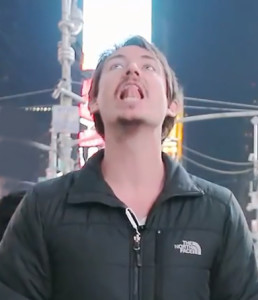How to learn vocals at home. How to learn to sing at home and develop your ear?
There is something creative in every person: someone is fond of drawing, dancing, someone has found himself in acting, someone sings, it’s about singing that we’ll talk about today. Or rather, about how to learn to sing beautifully and not be afraid of your voice.
Of course, every singer will tell you that learning to sing on your own is a very difficult task, you need a teacher, or better to say a master, who will give you a voice. Difficult - but realizable, therefore, a person who really wants to learn how to sing will do it, regardless of all the difficulties.
Singing is one of the most better ways self-expression of a person, his feelings and thoughts.
From this definition we can conclude that everyone can learn to sing beautifully, because we can convey our thoughts with the help of colloquial speech, so why not learn to do it through singing? Note that in order to learn to sing, it is not so important to have some kind of technique, it is much more important to treat this creativity with all your heart and soul.

Master class on singing by A. F. Vedernikov.
Ear for music
The first thing you need to do is start training your ear. You ask why hearing and not voice? - because your voice will rise during training, but many people have problems with hearing from the very first lessons. Let's deal with this concept so that further we can deal with a certain base.
Ear for music- a set of human skills that allow him to fully and objectively evaluate music or some sounds, see its advantages and disadvantages; hearing is the most an important factor for a successful musical activity person.
Varieties of musical ear
- Relative hearing is the ability of a person to find and reproduce pitch relationships in a melody, in music. intervals, etc. It should be noted that the pitch of a sound is determined by comparison with a reference sound. Relative hearing is essential tool for every professional musician.
- Absolute pitch is the ability of a person to find absolute altitude sounds, while not comparing them with reference sounds. This type of hearing is innate, and as scientists say, it cannot be obtained artificially (by various exercises), but nevertheless development in this activity continues.
- Intonation hearing is the ability of a person to hear the “expressiveness” of music.
- Inner hearing is the ability of a person to clearly imagine individual sounds, harmonic and melodic constructions in front of him. This is a type of hearing that allows you to hear and perceive music within yourself, without any external interference.
- Modal hearing is the ability of a person to distinguish the modal-tonal functions of each sound separately.
- Harmonic hearing is the ability of a person to hear chord combinations of sounds in their correct sequence, as well as to arpeggiate with his voice.
- Polyphonic hearing is the ability of a person in a song to simultaneously hear several separate voices (two or more).
- Rhythmic hearing - the ability to motor experience music, to feel musical rhythm and copy it exactly.
There are several other varieties of hearing, but I have drawn your attention to only these six main ones. It would be nice if you could tell them apart without any outline or cheat sheet.
How to Learn to Sing Vocal Lesson for Beginners #1
The nature of the musical ear
Musical ear is specifically associated with musical talent person expressed in more, his emotional experience and perception musical image. Various aspects and subtleties of musical ear are studied in such specialized sciences as psychoacoustics, musical psychology, psychophysiology of hearing, musical acoustics.
The development of musical ear

The development of hearing is engaged in such a special discipline as solfeggio. I note that ear for music Everyone has it, it just needs to be developed. So, let's start developing our ear, and the first thing we turn to is unison.
Unison is a phenomenon when sounds of different source sound at the same pitch. Our task is as follows: to learn to adjust our voice to any sound that we hear. To achieve this result, there are several exercises.
The first exercise "finger to the sky":
Are you wondering why it's called that? Because you have to select voices, making various sounds, and the first time, it is almost impossible to do this.
The essence of the exercise is as follows: being close to the source of the sound, try to repeat it, making different monotonous sounds (“oh-oh-oh-oh!”, “a-a-a-a!”, etc.), after a while you will definitely be able to repeat the necessary sound, the main thing is to train.
The second exercise "Carpet bombing":
The essence of the exercise: we stand next to the source of a monotonous sound, and begin to make different sounds with our voice, mumble, buzz, in general, experiment with the voice. We make sounds similar to the noise of a chainsaw, the rumble of an accelerating car or a flying plane, etc. In music this technique is called glissando, we will call it “entrance”, with our voice, we, as it were, collect all sounds in the direction downwards or upwards.
So how do we now determine when we have reached unison? - you ask. Everything is very simple, in physics there is such a thing as resonance, this is when two sounds merge into one and amplify it twice. It is when this phenomenon occurs that will mean that you have reached unison. After that, you will begin to have a stream of fantasy, it will be more and more interesting for you to do this, because. you have already achieved some success.
Well, we talked about such a thing as musical ear, and found out that this is the most important criterion in order to learn how to sing beautifully. After getting acquainted with a certain theory, we discovered 2 exercises to improve hearing. You need to do them regularly in order to constantly improve yourself.
Ability to hear yourself:
Another equally important factor is the feeling when you can objectively hear yourself from the outside. At first, your voice will be very disgusting to you, do not be afraid of this, this is a normal phenomenon. But over time, such a defect should pass, and then it will simply become necessary for you to record your voice, and then listen to them in order to analyze your mistakes. Let it be a voice recorder or computer programs, the main thing is that the sound is clear. By doing such exercises, you will get rid of many mistakes, and your voice will be more and more perfect.

In order to learn how to sing well, you need to learn how to breathe correctly. You should not breathe randomly, suffocating while singing and thus making unnecessary sounds. Breathing should be as close to normal as possible. Try to inhale sharply and exhale slowly and smoothly. It is very important to control the length of the exhalation and the depth of the inhalation. Breathing involves the muscles of the diaphragm and ribs. Note that oxygen must enter through the nose! In order to learn how to breathe correctly and do it easily, regularly perform the exercises that we will discuss below.
Now let's figure out exactly how breathing is involved in the process of singing. The source of the sound that comes from your body - vocal cords. The sound is obtained as a result of the closure of these same vocal cords. A jet of air that vibrates them comes from the bronchi, resulting in sound. This is the whole process in a big reduction, in fact it goes a little more complicated.
Let's analyze the exercises that develop breathing:
Exercise 1: Very useful exercise with a candle, which develops a smooth and slow exhalation. The essence of the exercise is as follows: put a lit candle in front of you (at a distance of 20 cm), draw a small amount of air through your nose into the lower part of the ribs. After that, exhale air smoothly and without unnecessary jerks in the direction of the candle, while the fire should not go out. This exercise will help you avoid unnecessary jerks and jumps when singing. In addition, the exercise develops the duration of the exhalation, which will positively affect your personal data.
Exercise 2: As mentioned earlier, in singing breathing, the lower ribs and diaphragm are most involved. This exercise is about this group muscles. Lie down on the floor or on any other hard surface, then put some kind of load in the abdomen (this can be several heavy books). Now you just need to breathe evenly for a short time. For beginners, this exercise may seem strange, but in fact, when performed, the muscles of the diaphragm are strengthened, which contributes to proper inhalation.
Vocal lesson. Sound attack. Singing on a pedestal. Jazz tricks
Important!
It was not in vain that we combined such concepts as breathing and articulation into one group, because. personal indicators of these data must be developed in the aggregate, otherwise the result will not be.
Now let's look at a few exercises for the development of articulation.
Exercise 1: This exercise develops chewing muscles, joints and ligaments. Open your mouth wide, mentally pronounce the vowel “A” and hold this position for 5 seconds. Do a few reps. Also, the exercise can be complicated by pressing on the lower jaw with a fist.
Exercise 2: This exercise strengthens the cheek muscles. Inflate in turn, then the right, then the left cheek, and then retract both. Do a few repetitions.
Exercise 3: Probably the well-known exercise is tongue twisters. Learn and repeat tongue twisters at high speed throughout the day, i.e. if you have a couple of free minutes, then you can devote them to this lesson. This way you will develop your language, and your words will not be distorted. At first, do not try to pronounce tongue twisters very quickly, let it be slow, but high quality. Be sure to pronounce the endings of words, and do not chew them. Over time, increase the pace, and soon, the result will make itself felt.

Emotions are a very important factor in singing. Agree, no one will be interested in listening to a person who came out and muttered something to you, yes, in fact, such a person will never be able to sing. I mean that going on stage, anyone creative person must present to people his attitude, his views and emotions on the object of his attention. IN this case we are talking about about songs. The singer needs to convey all the feelings inherent in the song, it can be feelings or, on the contrary, joyful emotions.
Therefore, before performing a song, be sure to tune in to it, feel its character, harmony, repeat it again and pay attention to all the little things. After all, knowing the song is a natural necessity, without which the performance will not work. After you understand the emotions, dilute them with a variety of gestures. Entire books are devoted to this topic, but I presented you brief information which is worth paying attention to.
As I said at the beginning of the article, it is best to hire a voice coach. He will thoroughly take care of your training, and most importantly, he will constantly point out your mistakes to you, which is impossible with independent training. Although here you will come to the aid of a voice recorder. If you still decide to study, then do not take days off for yourself and do not shirk from classes. Another very important factor in your success is constant performances in front of the public. It doesn't matter who it will be, the main thing is that yours is listened to strangers. Do not be afraid of criticism, this is your main teacher.
Group lessons are also a big plus. Firstly, you will have a greater interest in singing, and secondly, you will always learn from your partner.
This concludes this article. Good luck!
Not all people know that you can put your voice on your own and do not need to enroll in special circles.
But first you need to understand the most important and basic things.
You should feel all the vibrations of your body when you say something.
Why it's so important - analogy with punching a fist
Let's give an analogy with a punch from boxing.
- When the right blow is struck, the whole body is invested in it. It's not just waving one fist.
Body at right hit not static and is also embedded in it, and only then the blow becomes 10 times stronger and more dangerous to the enemy. - If you don't use the strength of your body when you strike with your fist and you don’t invest in it, then it will not be a blow, but simply a movement with one hand.
You should apply the same in conversation.
You must include your whole body in expressing yourself.
Take a deep breath and then speak, otherwise no one will hear you.
2. Use the right key
 There are 3 types of tones in total.:
There are 3 types of tones in total.:
- seeking / needy;
- normal;
- torn.
Seeking or needing tonality (1)
Also on the street, beggars come up to people on the street and ask for money. It's a seeker trying to please rapport.
For example:
- Time not prompt?
- Would you like to eat delicious pizza with me?
- My computer is broken, please fix it.
It is unattractive and disgusting.
Normal key (2)
 When you talk to a person completely neutral, without any special emotions.
When you talk to a person completely neutral, without any special emotions.
For example:
- We are fine today.
- I had a good time in the park.
- Dad bought a new car.
Ragged rapport (3)
From the side of presentation, this tone looks as if you don’t want anything from this person and as if you don’t really want to talk to him.
With this tone, you do not try to impress the interlocutor, you try less and strain less.
This tone will be useful for men to lead with women.
Examples of 3 keys:
- Actually, we had a great time yesterday.
- You have a great t-shirt.
- Let's go to our favorite place by the river.
To be centered and to be in a permanent state of communication, most people need to be spoken to in a ragged to normal tone. If most of the time your voice is between a ragged and normal key, and you also diversify it with sometimes seeking rapport, then your voice will be bold and funny at the same time. It will be fun and different at the same time.
Therefore, use all three types of key skillfully, and then you will know everything about how to deliver speech and voice. You will have a charming and unique tonality.
Remember that confidence plays a key role in communication. self-confidence for girls You can read the link on our website.
3. Get rid of excess mucus in your mouth in the morning
In the morning, everyone has this mucus and saliva in their mouth, which must be disposed of. They keep your voice from opening up.
Because of the mucus in their mouths, people often speak through their noses, as if they were voicing pirated movies. All voice and speech exercises are performed much easier and more productive if there is no excess mucus in the oral cavity.
 To get rid of mucus in your mouth as soon as you wake up clean your tongue with toothpaste and brush in the morning!
To get rid of mucus in your mouth as soon as you wake up clean your tongue with toothpaste and brush in the morning!
That is, when you go to brush your teeth, you also brush your tongue.
Thus, all excess mucus comes out of the mouth. Expectorate. You'll know when enough is enough.
The procedure is not so pleasant, but very useful. Takes approximately 3 - 4 minutes.
4. Warm up and draw vowels from high to low notes
Otherwise, then there will be internal resistance and the voice will not be congruent. ABOUT congruence in details we tell .
If you don't warm up, then whatever you say and do will worsen and worsen your communication and expression.
In order not to worry about how to develop a beautiful voice, use this useful exercise.
 Say these sounds in the same order in which they are indicated:
Say these sounds in the same order in which they are indicated:
When performing a vocal exercise for the voice with these sounds from "I" to "U", you go on a scale from high to low notes.
Walk over these sounds 2 times. Starting with alt"I", ending with a low "U".
It relaxes and opens your throat.
All of our exercises will help those who will subsequently openly express themselves and will not be embarrassed by their voice.
We have a full article on our website on how to stop being shy about people. She can be found.
5. Lowing
Mooing means pulling the sound "M". This is a well-known exercise in singing voice and must be done correctly. ![]()
With proper mooing, lips should itch.
If your throat itches, then you need to lift your neck higher.
Errors:
- Don't take in too much air.
- No need to moo like a cow. This is in no way effective and will not help development in any way.
- During the lowing and setting the voice in men or women, pain in the throat may appear. Stop immediately if these symptoms begin.
- During this exercise, do not try to hit high transcendental notes. That is, mumble at a neutral volume that does not bother you in any way.
- No need to strain the muscles of the face or jaw. All in a calm relaxed position, just as when pronouncing short sound"M".
6. Relieve tension from the throat and mouth
Order of execution:

You begin to tense your mouth, throat and neck a little, and in doing so you exercise and expand the possibilities of your voice in communication.
- Releases and releases tension from your neck, throat, and mouth.
- The voice and throat open.
- You begin to speak more clearly and distinctly.
- You start breathing deeper.
- The possibilities of the language are being used more when speaking.
You can watch this exercise visually in one of our video tutorials on how to put the voice on your own.
7. Good neck stretch
The exercise will be especially useful for those who spend a lot of time at the computer and want to know everything about how to develop their voice on their own.
 In people with sedentary work the neck and head are often compressed into an uncomfortable position, the chin is held too low.
In people with sedentary work the neck and head are often compressed into an uncomfortable position, the chin is held too low.
How to perform:
- Put your tongue on your upper teeth in the middle.
- Then raise your head and gently stretch your neck, tilting it slightly up, left, right, and forward.
- This is similar to how you stretch your muscles before you start to swing in the gym.
Benefits of stretching neck is that you start projecting your voice better, especially in noisy places.
Visual performance of the exercise, see below in the next series free videos voice lessons from scratch.
8. Repeating the word "Glap"
The essence of the exercise in that:

- The voice gets louder, clearer.
- It becomes easier to control and project it.
How to visually perform the exercise, see the next video from the series on how to put a voice for singing at home.
9. Trilling lips is very useful for setting the voice.
 This exercise is a bit like imitating a car engine. With it, you can put your voice correctly, especially when there is a visual video lesson below.
This exercise is a bit like imitating a car engine. With it, you can put your voice correctly, especially when there is a visual video lesson below.
It doesn't matter how it looks from the outside. The main thing is that it is effective.
The meaning of this in that:
- You relax your lips and imitate that trill sound.
- The vibration of the lips due to the exhalation of air makes them more mobile.
- In parallel, you can make smooth movements with the neck, so that it is more liberated. But this is optional.
It's like little boys playing with cars in the sandbox as kids.
For more details on how the exercise is performed, see the next video on how to develop a beautiful voice.
10. Exercise for diction
We pronounce any text with a closed mouth
How to perform in detail:

- Take any text or newspaper and start reading it closed mouth.
- You close your lips, and your teeth should be open.
- Pre-breathe more air and start.
It might not work out so well at first.
But, gradually, even with your mouth closed, your speech will be better perceived by people by ear and becomes more understandable.
Know that the result will come, do not lose motivation and.
What advantages can be identified:
- Opening your mouth later will make your speech even more intelligible. So, little by little, you will be able to develop your beautiful voice.
- Your speech will become pleasant, harmonious and clear.
See how the exercise is clearly performed in the next special video on how to put your voice at home, pronouncing the text with your mouth closed.
11. Repeat tongue twisters 10 times
The bottom line is that the muscles of the mouth expand and it becomes easier to communicate.
The effect of the exercise will be twice as much if you repeat the tongue twister with your mouth closed. We talked about this above in the 10th method.
There are a lot of different tongue twisters. For example:
- “Sasha has cones and checkers in his pocket”;
- "Mother Romasha gave whey from yogurt."
![]() Choose 2 - 3 you like and start repeating 10 times each. This last way will answer all your questions about how to improve your voice and diction.
Choose 2 - 3 you like and start repeating 10 times each. This last way will answer all your questions about how to improve your voice and diction.
Conclusion
After doing the exercises, you will want to get rid of excess mucus in your mouth.
This is very good sign and that's okay.
By doing these exercises in the morning, you will notice how in a month your voice will noticeably improve. Make time for yourself.
Don't Forget Confidence
Confidence is the main parameter for a good voice.
Speak confidently and without hesitation.
Now you know everything about how to put your own voice for singing.
Invest time in developing yourself, and the result will not keep you waiting.
They say that every person has a hearing and a voice, but some have developed this ability, while others do not. Is this true, and how can I fix it? In this article, Learn It will talk about exercises aimed at learning to sing and give many useful recommendations.
First you need to understand that people who have a natural talent for singing learn faster. That is, the learning process is directly envy from natural data. However, this does not mean that only such people can learn to sing, since vocal technique takes big role, and everyone can learn to control the voice as an instrument.
Do not believe if you are told that it is impossible to learn to sing from scratch! Everyone can achieve what they want! Even those who were asked not to spoil the sound of a song and shut up. But prepare for difficulties. You will need a lot of time, patience and strength.
- The first thing a novice vocalist needs to do is stop being afraid to manage own voice and learn to “feed” it.
- Worth learning correct breathing belly! While singing, do not try to take in a full chest of air. Imagine that you have a light rod inside you from your stomach to your throat, the base of which is in your stomach. When you make a sound, the stomach should not retract, it should grow. Don't forget to learn to sing, you need to breathe correctly! In addition, if you develop the respiratory system, it will help strengthen the blood vessels, and this will help you get less colds, and the immune system will become stronger.
- If you have speech therapy problems: incorrect pronunciation of sounds, stuttering, etc. - vocals can overcome this effectively and quickly. He perfectly copes with congenital and acquired speech defects and develops diction. The main thing is your desire!
- Recitative reading of texts and tongue twisters will help develop the correct declaration. Golden Rule art - consonants are pronounced, vowels are sung.
- In addition to notes, there is also musical notation (musical signs, the duration of notes, the size of the work - becar, sharp, grace notes, pauses, notes, tonality, etc.). Mastering all this is quite difficult, but in order to easily read musical texts, it is necessary.
- Well, if you have, in addition to the desire to sing, there will also be a desire to play a musical instrument. Thanks to this, the question “how to learn to sing beautifully” is solved twice as fast.
Exercises
- To sing beautifully, it is not at all necessary to attend singing schools and generally leave the house. You can learn this with the help of fairly common and popular distance trainings and online classes. Especially if you are not going to attend professional classes. Therefore, if you decide to dedicate a song to your beloved or beloved, but at the same time want to look decent, UchiEto picked up a few tips:
- Stand in front of a mirror and do these exercises. Start singing the vowels: e, s, u, o, i, e, a. On “s” - imagine that you are painting your lips - the mouth should be half open so that a noticeable smile can be seen. On the “o”, make a bagel with your mouth. On “and” - the corners of the lips begin to reach for the ears, so that it looks like you are smiling. On "e" and "e" - remember opera singers, open mouth with spruce noticeable smile. On “a” - the mouth must be opened wide so that the lower jaw conditionally reaches the chest. Now sing all the vowels in a row, considering singing on the stomach and how to open your mouth. Do this every day, and when it works out, you can move on to the works. But remember that everything should have a golden mean, do not overdo it.
- Before you learn how to sing beautifully, for yourself or professionally, you should learn a couple of chants. You probably remember them from your school days. Popular “mi-me-ma-mo-mu” and others. This is necessary to warm up the ligaments and prepare them for prolonged singing. After all, if you do not prepare, the voice can simply wheeze, break, and more.
- When choosing a song to sing along with a backing track, you need to consider that it is in your key - so that it is convenient to sing (not high and not low). Even if you learn to sing beautifully, but choose a work not in your key, everything will be in vain.
- Don't sing outside, especially when it's cold. Before singing, do not eat cookies, bread, chocolate and do not drink cold drinks.
The human voice is a unique musical instrument given to us by nature itself. It has many advantages over musical instruments created by human hands. Namely, he is always with us, at any time and in any place, he also has the ability, in addition to music, to reproduce words. Agree, listening to a song is usually more interesting than just music. That is why there are so many people who, for some reason, cannot sing, but really want to learn.
But how to learn to sing on your own at home? As much as possible? Let's consider these questions.
Can everyone sing?
Many people are firmly convinced that "a bear stepped on their ear." In other words, they believe that they have no ear for music. Not really! Don't believe these claims! Absolutely everyone has a hearing, it’s just that for some people it is in its infancy, that is, it is not developed at all.
Of course, if a child was born into a family of musicians and is surrounded by music every day, his ear for music will develop on its own. Another thing is, if from birth he does not hear music, no one sings to him, then he musical ability will not develop.

The same goes for singing. If a child does not become interested in singing from childhood, does not burn with a desire to sing, then, of course, he will not do this in adulthood. That is why the question arises as to whether it is possible to learn to sing. Therefore, we can say with confidence: everyone can sing, you just have to really want it.
What do we need for vocals?
Now that we have already decided whether it is possible to learn to sing with a desire, we need to understand what components we need for this purpose.
So, first of all, you need an appropriate room with good acoustic data. The voice should not fly high or sound muffled, as in a small enclosed space. Acoustics should be normal, without unnecessary overtones. Many teachers recommend singing in rooms where there is big windows, which reflect sound very well and are additional resonators. When you hear the glass clinking, it means that they are already vibrating!
You also need to be in good health and not have any serious diseases that could interfere with vocal lessons on the way to resolving the issue of how to learn to sing beautifully.

The last factor, but probably the most important one, is faith in yourself, in your abilities, which are actually limitless. In other words, the development of musical and vocal technique is a matter of thoughtful work. Everything comes from the head, so the question of how to learn to sing beautifully is also from the field of psychology.
Help of nature
Nature has created all the conditions for a person to not only sing, but also do it very beautifully. For this purpose we have been given the so-called resonators.
What is it? Resonators are such places in our body, when they hit them, the sound is amplified many times, becomes more powerful, fuller and more voluminous. They will answer the question of how to learn to sing well. By themselves, the vocal cords are not able to give us such a strong sound. Knowing your resonators and owning them, you can understand how to learn how to sing beautifully. And it won't be like that difficult task, it's all about technique and desire!
Looking for resonators
When you master the science of resonances, it will immediately become clear how to learn to sing from scratch. The word "resonance" in translation from French means "resonance". Resonance is able to amplify the sound, like a microphone. It is he who is responsible for the lightness of the voice, its beauty and flight. If you just put pressure on the ligaments, nothing good will come of it, except for their breakdown. A lot of people who try themselves in vocal skills and do not know how to learn to sing on their own begin to do this, relying on the ligamentous apparatus. As a result, the larynx is clamped, an unpleasant feeling of clamping appears in the area of the ligaments, which is very uncomfortable and threatens with hoarseness for the voice.

What to do? Look for resonators! There are a lot of resonators on our body, especially on the head. For the most part, they are located in the hard bones of the skull, jaws, and maxillary sinuses. Even the teeth reverberate! Therefore, first you need to understand well where these resonators are located.
Is talent needed?
When you start thinking about how to learn to sing on your own, a natural answer arises: you need talent. Yes, indeed, talent is a very useful thing, making life easier in many things, however, as many say famous people, success most often depends mainly on diligence. This is true. The ability to sing beautifully, so as to win people's hearts, comes gradually. Namely, a person must first develop a sense of beauty in himself.

You need to hear in your head the voice that you want to strive for. In order to hear it, you need to imagine it. But for this you already need to have a well-developed imagination. What to do if the imagination is not developed well enough? We'll fix everything! Imagination lends itself well to "training". Shall we try?
- Look at the clouds and try to see an image in them. At first this will seem like a difficult task, but that's the whole secret, to see the first thing that catches your eye. No need to try to squeeze something out of yourself, everything should be easy and at ease.
- Take any 3 words, preferably nouns, and try to come up with a coherent sentence with them. Let such a proposal sound ridiculous, it does not matter, the main thing is that it worked out.
Such simple tricks will help solve the problem of lack of imagination, since it is more contrived than existing. Every child has a well-developed imagination. The only trouble is that, growing up, we forget what it's like to be a child.
Search for a teacher
When people are wondering how to learn to sing beautifully, many come up with the idea to turn to the help of professionals. This is very justified, because a talented teacher will help to avoid many mistakes that can be made while studying on your own. In this case, you will have to relearn, and as you know, it is easier to learn again.

However, it is not so easy to find a person who will be both a good teacher, And good singer. Very often the most best singers they cannot explain to the student well and competently what and how to do for the correct sound production, and vice versa. Nevertheless, if such a desire arose - to find a teacher for yourself, you should not neglect it. He who seeks will always find, and this is a fact.
high notes
High notes are considered the edge of the range and are therefore especially difficult to sing. And the person begins to think about how to learn to sing high.
Everything is very simple. Let's use the imagination again. We imagine that high notes- not so high at all, and that there are notes that are even higher. In this case, singing high will no longer seem so difficult.
We will not hesitate to connect our natural resonators, they must all vibrate and respond. The sound should fill all our sinuses and pour not only from our mouth, but literally from our whole body.
Improving singing technique
In addition to the aforementioned resonators, a person who wants to master the technique of vocals also needs to correctly set the performing breath. This is not as simple as it might seem at first glance. We all breathe and it gives us life. The breath of a vocalist, however, requires work and practice.

First of all, it is necessary that it be voluminous and that it be enough for long phrases and passages. It is also important that it be diaphragmatic, or, more simply, that it rests on the diaphragm.
All this is achieved by practice and careful self-control. At first, of course, it is difficult to control so many things at the same time, namely: to monitor the correctness of your breathing, do not forget about the resonators, and also follow the progress of your singing. Everything comes with time and practice. Gradually, you will notice how it becomes easier and easier for you. You will already be picking up more complex repertoire or songs that will suit you better. The extreme notes of the range will no longer seem intimidating and will be taken easily and naturally.
Believe in yourself and be patient, and you will not notice how quickly you will learn to sing beautifully and will no longer wonder how to learn to sing on your own.
So, let's find out how to learn to sing on your own.
Stages of learning
Basic exercises
- First of all, you need to learn how to adjust the sound of your voice to any sound. First you can try on any sound, then move on to the pressed piano key. Try again and again, sooner or later you will succeed. You can hear it when two sounds have merged into one. Practice with simple sounds first, then move on to complex ones. Then you can move on to real songs, that is, sing along to your favorite singers. You must learn to sing in unison. Read the article about learning to sing
- After you can sing in unison, move on to the next exercise. Sing the sounds Oh, U, I, E. First sing them separately, and then combine and sing, for example, OY, OU, and so on.
- Once you've mastered the vowels, move on to syllables. That is, combine consonants and vowels. For example, sing: ma-mo-mi-me-mu-we-me.
An important step in learning to sing is breathing exercises. They will help develop the organs that are responsible for sound production, these are the vocal cords, the diaphragm, the muscles of the larynx.
Breathing exercises
- So, inhale the air through your nose sharply and noisily, and exhale smoothly. You must learn to breathe in this way, to control the depth of the breath. Such a breath should be enough to then sing the desired phrase as you exhale. Also learn to hold your breath, it is also very useful for the development of the respiratory organs.
- Another good exercise is the pronunciation of hissing consonants. To perform it, you need to take air with your nose, and slowly pronounce the letter at the exit (for example, “s”).
Articulation and diction
Important for singing and articulation. They will help improve the diction of the tongue twister. Inhale through your nose and say the tongue twister, then exhale. Sounds must be pronounced clearly, the endings of words must be audible. Speak slowly at first, and then gradually speed up the pace.
And besides, you have to learn to listen to yourself, so record yourself and then listen. You will immediately hear where you sing wrong, where you need to sing differently. You can read about the correct singing in the article
Remember that any teaching is work. Therefore, practice more often, and you will succeed.







